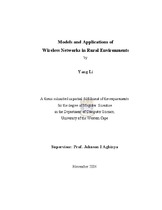| dc.contributor.advisor | Agbinya, Johnson I. | |
| dc.contributor.author | Li, Yang | |
| dc.contributor.other | Dept. of Computer Science | |
| dc.contributor.other | Faculty of Science | |
| dc.date.accessioned | 2013-06-14T06:51:10Z | |
| dc.date.available | 2007/04/16 13:59 | |
| dc.date.available | 2007/04/16 | |
| dc.date.available | 2013-06-14T06:51:10Z | |
| dc.date.issued | 2005 | |
| dc.identifier.uri | http://hdl.handle.net/11394/1410 | |
| dc.description | Magister Scientiae - MSc | en_US |
| dc.description.abstract | With the unprecedented growth of the communication industry that the world is experiencing, the demand from rural inhabitants for high quality communications at an economically affordable cost is growing. However, rural areas are rather restricted from deploying communication services due to the rough natural environment, and the shortage of rudimentary communication facilities and technical personnel. Appropriate models for building rural wireless networks and a concomitant simulation environment are, therefore, expected to enable the construction of technologically-optimal and economically-efficient networks in specified rural areas.The research has set up two independent models, one for the economic need and the other for the technical need of building networks in rural areas. One model was the Impact of Telecommunications Model, which disclosed the importance of building a wireless network in specified rural areas by choosing an economic parameter to forecast the profitability of the network. The other was the Service Model, which collected primitive data from given rural areas and abstracted these data by flowing them through four technical layers to form the predicted technical wireless network. Both of the models had been applied to real-world cases to demonstrate how to use them.A simulation environment was finally designed and implemented to realize the above two models for the sake of instantiation. This environment could simulate the specified rural network by constructing a wireless network on the invented areas and evaluating its quality and economic efficiency. It was written in Scilab simulation language, which was an open source. | en_US |
| dc.language.iso | en | en_US |
| dc.publisher | University of the Western Cape | en_US |
| dc.subject | Wireless communication systems | en_US |
| dc.subject | Data transmission systems | en_US |
| dc.subject | Telecommunication | en_US |
| dc.subject | Technological innovations | en_US |
| dc.title | Models and applications of wireless networks in rural environments | en_US |
| dc.type | Thesis | en_US |
| dc.rights.holder | University of the Western Cape | en_US |
| dc.description.country | South Africa | |

